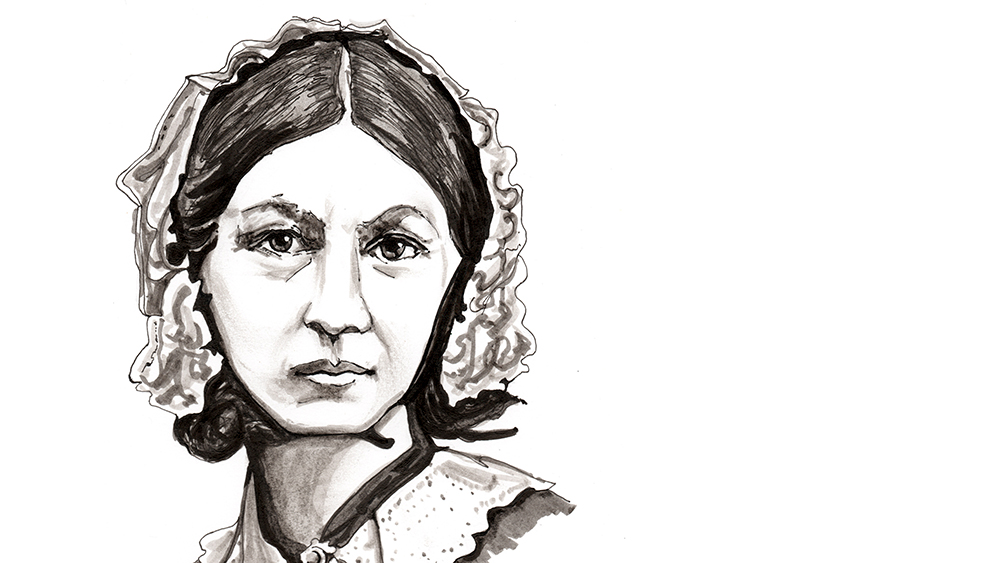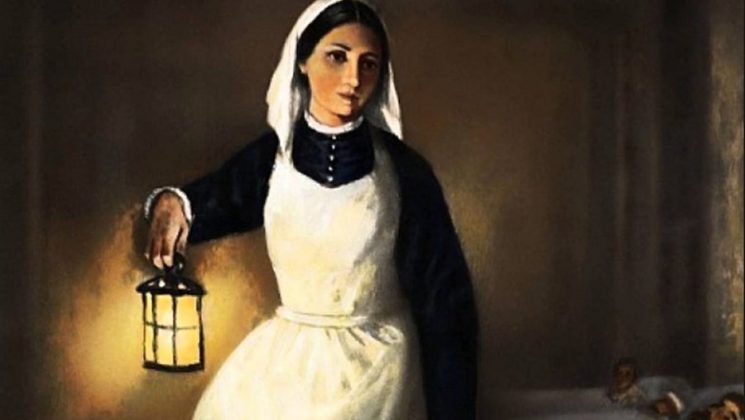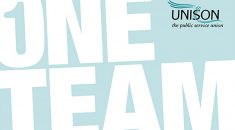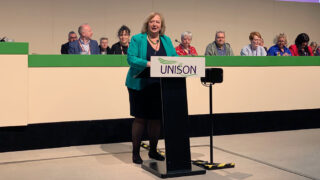Florence Nightingale is such a British icon that, almost 110 years after her death, the mere mention of her name still conjures an instant image: the intense gaze, austere hair topped by a bonnet. Search online and you’ll find myriad representations of her carrying a lamp through the wards of the military hospital at Scutari, Turkey, her presence giving comfort to soldiers wounded in the Crimean War.
Nightingale has featured on big and small screens, played by talents as diverse as British film star Anna Neagle and Charlie’s Angels actor Jaclyn Smith. There have been stage plays and radio plays; an asteroid, a Dutch airplane and a US Navy ship have been named after her; she’s been on stamps across the world and carried her lamp on British tenners from 1975 until 1994.
But why, 200 years after her birth, is this Victorian woman being so celebrated? Who really was Florence Nightingale?
Beginnings
From a well-to-do family, Florence Nightingale might have been expected to follow a template of female life: a few good works here and there, a spot of socialising, having children. It was a model she herself frowned upon.
But, unusually, her father believed that learning wasn’t just for boys, and decided to educate her himself. Equally unusual for the time, her curriculum included maths, for which she clearly had a gift.
Education aside, her life started pretty conventionally. Visits to the sick and poor opened her eyes to suffering. But in the first half of the 19th century women of her class didn’t become ‘nurses’. Most were widows and unemployed servants desperate for a way to make a living.
In his novel Martin Chuzzlewit (1842-44) Charles Dickens portrayed Sarah Gamp, a nurse, as untrained and incompetent. It wasn’t far from the truth. Hospitals were dire places with straw-strewn floors to soak up blood.
Unsurprising, Nightingale observed: “It may seem a strange principle to enunciate as the very first requirement in a hospital that it should do the sick no harm.”
Growing awareness
It’s often said that travel broadens the mind. It was certainly true for Nightingale. Her writings from abroad reveal her learning, literary skill and personal philosophy. While she remained a Christian to the end of her life, she didn’t hold other faiths in disdain.
She first felt a calling to do something selfless in 1837, and again when she travelled abroad in 1850.
Whilst travelling in Athens, Nightingale rescued a small owl being tormented by children; she named it Athena and often carried it around in a pocket until it died.
Her travels took her to a Lutheran religious community at Kaiserwerth-am-Rhein in Germany, where she observed Pastor Theodor Fliedner and deaconesses working for the sick and deprived. She spent four months at the institute training as a nurse.
In late summer 1853, she took the post of superintendent at the Institute for the Care of Sick Gentlewomen in London – thanks to her father giving her an annual income of £500.

To the battlefield
Nightingale’s iconic status was well and truly made in Crimea.
As reports of the horrific conditions for the wounded in the Crimean War drifted back to Britain, Nightingale and 38 women volunteers – including her own aunt and 15 Catholic nuns – were sent under the authorisation of her friend and the then Secretary of War, Sidney Herbert, to the Ottoman Empire.
Arriving early in November 1854, they found an overworked team caring for soldiers, with medicines running short, hygiene almost non-existent – and official indifference.
In her first winter there, 4,077 soldiers died. Of that toll, 10 times more died from the likes of typhus, typhoid and dysentery than from battle wounds.
At her insistence, in March 1855 the government sent out the Sanitary Commission. It flushed the sewers and improved ventilation – moves that saw the death rate fall sharply.
Nightingale herself never claimed credit for this, but in the Dictionary of National Biography, Stephen Paget states that she reduced the death rate from 42% to 2% – a situation massively helped by her introduction of hygiene measures to the hospital, including handwashing.
Some more recent commentators have suggested that Nightingale’s impact in the Crimea was overstated at the time. But against the background of nursing and hospitals outlined earlier, and the huge failures and mismanagement in the way that the war itself was conducted, there was a demand for professionalisation. Nightingale was a rare example of precisely that.
After the Crimea
Back in Britain, Nightingale began collecting evidence before the Royal Commission on the Health of the Army, coming to understand that the living conditions of both soldiers and civilians were crucial factors to health.
Her later career saw her campaign for better sanitary conditions. When that reduced peacetime military deaths, she turned her attention to the sanitary design of hospitals and working-class homes.
She also conducted research on the Army in India, demonstrating that bad drainage, contaminated water, overcrowding and poor ventilation were causing the high death rate among soldiers.
Producing a statistical survey of Indian rural life, Nightingale became a leading figure in the introduction of improved medical care and public health service in India. Ten years of sanitary reform saw mortality among soldiers drastically drop from 69 to 18 per 1,000.
A gift for maths
In all this, her gift for maths was a help. Nightingale became a pioneer of the visual presentation of statistics, developing a form of the pie chart.
And the founder of modern nursing continued to have an impact. From the 1860s on, trained nurses were introduced into workhouses, so that sick paupers were no longer treated by other paupers.
At the beginning of that decade, she set up the Nightingale Training School at St Thomas’ Hospital in London. The first graduates began work in May 1865 at the Liverpool Workhouse Infirmary. Now called the Florence Nightingale School of Nursing and Midwifery, it’s part of King’s College London.
This is without mentioning her contributions to literature, feminism and even theology. Nightingale was a prodigious writer on a range of subjects.
International Nurses Day
Back in the medical world, the Nightingale Pledge is a modified version of the doctors’ Hippocratic Oath and is taken by nurses at the end of nursing training.
Since 1965, International Nurses Day has been celebrated on 12 May – Nightingale’s birthday.
When writer and critic Lytton Strachey was penning Eminent Victorians – his 1918 debunking of iconic Victorians and the idea of that era as being particularly moral – he came up short with intended target Nightingale, who he depicted as intense, driven and difficult.
It’s hard to imagine that she could have accomplished what she did, against a background of enormous restrictions on women, if she hadn’t been all of that – and more. And Strachey the iconoclast – like many others since – found that he had to bow to the achievements of a true icon.




What a wonderful tribute to Florence Nightingale on her 200th birth anniversary! It’s fascinating to delve beyond the iconic image of ‘The Lady with the Lamp’ and explore the depth of her life and contributions. Florence Nightingale’s pioneering work in modern nursing laid the foundation for the healthcare profession as we know it today. Her dedication, compassion, and relentless efforts to improve healthcare practices continue to inspire generations of nurses worldwide. Thank you, Amanda Kendal, for shining a light on this remarkable woman and reminding us of her enduring legacy.